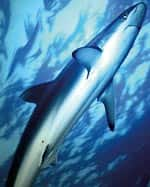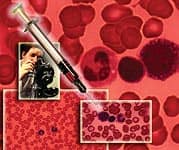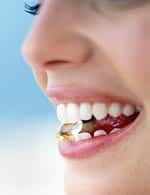Life Extension Magazine®
With their toothsome maws and machine-like killing efficiency, the primitive creatures known as sharks have long inspired fear and commanded respect. But does this ancient family of boneless fish harbor a secret weapon against some of the most dreaded cancers afflicting humans? Centuries ago, Scandinavian practitioners of folk medicine adopted the habit of consuming shark liver oil as a general health tonic. In recent decades, scientists have observed that tumors are remarkably rare in sharks, and that these predatory fish are notoriously resistant to infections.1 This amazing imperviousness to disease doubtless inspired the folk remedy. Admittedly, fighting disease with shark oil sounds far-fetched. The very notion evokes unsavory images of cure-all tonics and unscrupulous charlatans from centuries past. But in 1952, Dr. Astrid Brohult stumbled upon remarkable proof that shark oil actually works. The fascinating story of her discovery, related by some of her colleagues in the book Shark Liver Oil: Nature’s Amazing Healer,2 provides a glimpse at the happy serendipity that occasionally results when science and intuition mix. A Hunch Pays OffDr. Brohult was a young Swedish oncologist working with leukemia patients in a children’s hospital. Leukemia is a potentially deadly cancer that affects white blood cells, or leukocytes, which are the immune system’s front-line defensive players, manufactured in the bone marrow. When leukemia strikes, leukocyte production runs amok. To stop the disease, patients are exposed to enough radiation to kill the cells in the bone marrow that give rise to both red and white blood cells. This drastic treatment is usually effective, but occasionally may be worse than the disease itself. With fewer red blood cells to carry oxygen and remove wastes, and few leukocytes left to fight infection and marshal other defenses, patients are rendered weak, deathly ill, and prone to infection. In an effort to stimulate her patients’ bone marrow to resume normal function, Dr. Brohult administered calve’s marrow to the children in her care. She was operating on little more than a hunch. Parents in Scandinavia have long served bone marrow soup to their children in winter, in the belief that it builds strength. Dr. Brohult reasoned that healthy bone marrow from calves might trigger a resumption of healthy function in humans. Her hope—and desperation—paid off. Although the results were inconsistent, some of her patients quickly experienced remarkable improvements, including a normalization of white blood cell counts and a striking return of energy.2,3 While exhilarated, Dr. Brohult immediately faced the problem of isolating the active component in the marrow in order to devise a more palatable source of the wondrous substance.
Getting to the SourceIt took another decade before a team led by Dr. Brohult’s husband, a research biochemist, isolated the active ingredient in calve’s marrow that normalizes white blood cell production. The chemical was actually a group of compounds, now known as alkylglycerols, or AKGs. Chemically speaking, AKGs are glyceryl ether lipids. Principal alkylglycerols are chimyl, batyl, and selachyl alcohols.1 Ironically, two Japanese scientists, who evidently did not appreciate the importance of their discovery, had discovered AKGs in deep-water sharks as early as 1922. AKGs occur naturally in various mammalian tissues, including most organs responsible for producing blood cells, such as the bone marrow and spleen. Interestingly enough, AKGs are also found in human breast milk, and are now thought to contribute significantly to an infant’s immunity, especially while the immature immune system is at its most vulnerable. In fact, human breast milk contains up to 10 times more AKGs than does cow’s milk.4 Coming full circle, Dr. Brohult’s team eventually determined that none other than the Greenland shark—found off the shores of their native Sweden—is a perfect source of concentrated AKGs. We now know that AKGs occur naturally in the human body, albeit in far smaller amounts than are found in shark liver. The reason for sharks’ abundant supply has to do with an ancient evolutionary adaptation to a literally crushing problem: how to maintain buoyancy at extreme depths of 5,000 feet or more. Primitive sharks evolved an ingenious ballast system: a specialized liver that allows them to maintain neutral buoyancy at a range of crushing depths. Sharks’ livers are unusually large, bulging with a carefully orchestrated mixture of complex lipids. Known collectively as shark liver oil, this cocktail of compounds allows the shark to rise and fall throughout the depths with relative ease. A Potent AntioxidantDr. Brohult and other scientists continued to study AKGs and quickly discovered that they inhibit cancer proliferation1 and prevent radiation sickness.5 The latter finding is especially significant. Radiation slices through cells like hot knives through butter, damaging the cells at the molecular level and generating free radicals that propagate destruction in a kind of chain reaction. Most antioxidants do a good job of neutralizing free radicals in the bloodstream and within the tissues, but few are capable of penetrating the cell membrane to enter individual cells. AKGs appear to act within individual cells, as suggested by clinical studies of patients receiving AKGs in combination with ionizing radiation.5-8
The ability of AKGs to protect people against the harmful effects of ionizing radiation was discovered more or less by accident. At about the time Dr. Brohult first began experimenting with AKGs on the children’s cancer ward, a nurse in Stockholm was accidentally exposed to radium, receiving a dangerously high dose of radiation. Her white blood cell count plummeted to unhealthy levels, and for more than a year she struggled with numerous infections. After receiving supplemental AKGs, her white blood cell count returned to normal and remained stable thereafter.9 In subsequent research, doctors found that administering shark liver oil orally before, during, and after radiation treatment for cervical cancer reduced the incidence of radiation-induced injuries by about 50% compared to control patients who received radiation alone.5,6,8 While such injuries are an often-unavoidable consequence of aggressive radiation treatment, most do not affect survival. So-called complex injuries due to the combination of tumor growth and radiation, however, are another story. Mortality for these patients ranges from 90% to 100% at five years, depending on tumor stage. Compared to control patients, the incidence of these complex injuries in patients supplementing with shark liver oil was significantly reduced, by about one third.5,6,8 Powerful Anti-Tumor EffectsDr. Brohult’s team was surprised to discover that when AKGs were given to cervical cancer patients, tumors regressed even before radiation treatment began, a finding that was soon replicated by others.10,11 More recently, scientists have determined that AKGs probably accomplish this feat by directly interfering with cancer cell sig-naling, which is crucial to tumor growth and metastasis.12-14 In a 1986 Swedish study, re-searchers divided women with cancer of the uterine cervix into two groups. One group of 284 women received shark liver oil before, during, and up to six months after high-voltage radiation treatment. A second group of 525 women with the same disease-stage profile received only radiation treatment.15 One-year survival among patients in the AKG group was 88%, versus 82% among radiation-only patients. While this difference is small, survival rates at the five-year milestone were dramatically higher among AKG patients. Sixty-five percent of women who had taken shark liver oil were still alive after five years, versus just 51% of women in the control group. Researchers concluded that treatment with AKG-rich shark liver oil reduced mortality significantly compared to control patients, an effect especially pronounced among patients younger than 60.15
While the mechanism by which AKGs reduce radiation side effects is not exactly clear, they appear to penetrate cell membranes and mop up free radicals.2 AKGs also amplify platelet-activating factor synthesis, which might help reduce radiation-induced bleeding by promoting platelet aggregation.2,16 But their benefits do not end there. Recent research indicates that AKGs inhibit activation of protein kinase C, which is essential for the runaway cell proliferation that is a hallmark of cancer.17,18 AKGs also directly boost the immune system by stimulating production of white blood cells called neutrophils and by activating macrophages.1,19 Macrophages are a type of white blood cell that plays a pivotal role in protecting against bacterial and fungal invaders. Thus, AKGs may help boost the immune system and help fight infections.2 Laboratory research on several types of colon cancer cells indicates that AKGs inhibit tumor growth and render existing cancer cells less likely to invade new tissue.20 In 2003, Swedish researchers published a report detailing the effects of shark liver oil on five types of human tumor cells, including ovarian, breast, and prostate cancer cells. They concluded that a commercially available form of shark liver oil from Norway, containing a standardized concentration of AKGs and their methoxy derivates, prompted all types of cancer cells to commit cellular suicide or to be halted in their tracks, thus dying without reproducing. As noted in their report, “the prostate cells . . . showed a dramatic reduction in the colony number even after relatively small doses . . .”1 The vascular networks supplying vital nutrients that help fuel tumor growth have long been a target of anti-cancer research. Shark oil has been reported to starve tumors by interfering with the development of this blood supply. Recently, researchers reported that this effect is likely mediated by the presence of AKGs in shark liver oil.21,22 Squalene Also Counters CancerSqualene is another major component of shark liver oil. Common in nature, squalene is a hydrocarbon that makes up a significant portion of the oily secretions that preserve the integrity of our outer layers of skin. It is also found in olive oil, and is believed to be responsible for some of the benefits of the Mediterranean diet, which, according to epidemiological studies, include a significantly lower incidence of cancer and heart disease.23,24 In Greece, for instance, women with a high olive oil intake have a breast cancer rate that is only one third that of American women. It is estimated that some individuals may consume up to 400 mg of squalene per day in countries where olives and olive oil play an indispensable role in the diet.24,25 Laboratory research on animals and human cancer cells confirms squalene’s cancer-fighting effects.26-31 | ||||
Additional Potential BenefitsAccording to Shark Liver Oil: Nature’s Amazing Healer, “AKGs, taken in the form of shark liver oil . . . will improve the quality of life and ease the aging process.” One of the book’s authors, Dr. Ingemar Joelsson, worked for years with the Brohults in Sweden, and has published numerous medical journal articles on the benefits of shark liver oil and AKGs. Taken as a dietary supplement, say the book’s authors, this natural immune system booster “helps increase general well-being, stave off common viruses and infections, and battle more serious diseases . . .”2 Dr. Joelsson and his coauthors cite multiple benefits of shark liver oil supplementation, based largely on anecdotal evidence and their combined years of experience as physicians and researchers. Although few controlled studies are available to support these claims, it is interesting to note the remarkable benefits reportedly experienced by their patients, including significant improvements in allergy symptoms, alleviation of asthma symptoms, and even relief from chronic pain. According to the authors, in 1992 the Brohults were granted a patent for a method of treating allergies and asthma with AKGs. The book also describes positive changes in skin conditions such as dermatitis and psoriasis with the use, both topical and oral, of shark liver oil. Indeed, it has been used topically to treat dry skin and wounds for centuries by native Scandinavians.2 Safety and DosagesConsumption of shark liver oil has no known side effects,17 though excessive amounts may result in stomach upset or diarrhea, and individuals who are allergic to shark meat may suffer an allergic response to the oil. Shark liver oil has been available for consumption by the public for more than 40 years, especially in Scandinavia, where it is a popular preventive and therapeutic agent.17 It is important to recall that AKGs occur naturally within the human body, albeit in far smaller amounts than are available through supplementation. The scientific literature supports the use of 100-150 mg of alkylglycerols daily for general immune system enhancement.17 Published clinical data by Dr. Astrid Brohult suggest that 0.3-2.6 grams (300-2600 mg) of alkylglycerols daily may help minimize the decrease in platelets and white blood cells associated with radiation treatment for cancer, with an apparent optimal dosage of 600 mg of alkylglycerols per day.32 Animal studies have also shown that alkylglycerols can increase white blood cell and platelet counts.33-36 Therefore, consuming alkylglycerols for more than 30 days consecutively should be done with physician supervision. Although much research remains to be done on the numerous potential benefits of shark liver oil, past research indicates that this gift from the deep holds enormous promise for anyone wishing to enhance immunity, fight cancer, and promote general health. Please Note: Do not consume shark liver oil for more than 30 days continuously without first consulting your physician. | |
| References | |
1. Krotkiewski M, Przybyszewska M, Janik P. Cytostatic and cytotoxic effects of alkylglycerols (Ecomer). Med Sci Monit. 2003 Nov;9(11):I131-5. 2. Solomon N, Passwater R, Joelsson I, Haimes L. Shark Liver Oil: Nature’s Amazing Healer. Kensington Books; 1997. 3. Brohult A, Brohult J, Brohult S. Biochemical effects of alkoxyglycerols and their use in cancer therapy. Acta Chem Scand. 1970;24(2):730. 4. Hallgren B, Niklasson A, Stallberg G, Thorin H. On the occurrence of 1-O-alkylglycerols and 1-O-(2-methoxyalkyl)glycerols in human colostrum, human milk, cow’s milk, sheep’s milk, human red bone marrow, red cells, blood plasma and a uterine carcinoma. Acta Chem Scand B. 1974;28(9):1029-34. 5. Brohult A, Brohult J, Brohult S, Joelsson I. Effect of alkoxyglycerols on the frequency of injuries following radiation therapy for carcinoma of the uterine cervix. Acta Obstet Gynecol Scand. 1977;56(4):441-8. 6. Brohult A, Brohult J, Brohult S, Joelsson I. Effect of alkoxyglycerols on the frequency of fistulas following radiation therapy for carcinoma of the uterine cervix. Acta Obstet Gynecol Scand. 1979;58(2):203-7. 7. Brohult A, Brohult J, Brohult S. Effect of alkoxyglycerols on the serum ornithine carbamoyl transferase in connection with radiation treatment. Experientia. 1972 Feb 15;28(2):146-7. 8. Brohult A, Brohult J, Brohult S. Effect of alkoxyglycerols on the frequency of injuries following radiation therapy. Experientia. 1973 May 1;29(1):81-2. 9. Brohult A, Holmberg J. Alkoxyglycerols in the treatment of leukopaenia caused by irradiation. Nature. 1954 Dec11;174(4441): 1102-3. 10. Brohult A, Brohult J, Brohult S. Regression of tumour growth after administration of alkoxyglycerols. Acta Obstet Gynecol Scand. 1978;57(1):79-83. 11. Boeryd B, Hallgren B, Stallberg G. Studies on the effect of methoxy-substituted glycerol ethers on tumour growth and metastasis formation. Br J Exp Pathol. 1971 Jun;52(3):221-30. 12. Samadder P, Richards C, Bittman R, Bhullar RP, Arthur G. The antitumor ether lipid 1-Q-octadecyl-2-O-methyl-rac-glycerophosphocholine (ET-18-OCH3) inhibits the association between Ras and Raf-1. Anticancer Res. 2003 May;23(3B):2291-5. 13. Arthur G, Bittman R. The inhibition of cell signaling pathways by antitumor ether lipids. Biochim Biophys Acta. 1998 Feb 5;1390(1):85-102. 14. Pedrono F, Khan NA, Legrand AB. Regulation of calcium signalling by 1-O-alkylglycerols in human Jurkat T lymphocytes. Life Sci. 2004 Apr 16;74(22):2793-801. 15. Brohult A, Brohult J, Brohult S, Joelsson I. Reduced mortality in cancer patients after administration of alkoxyglycerols. Acta Obstet Gynecol Scand. 1986;65(7):779-85. 16. Cheminade C, Gautier V, Hichami A, et al. 1-O-alkylglycerols improve boar sperm motility and fertility. Biol Reprod. 2002 Feb;66(2):421-8. 17. Pugliese PT, Jordan K, Cederberg H, Brohult J. Some biological actions of alkylglycerols from shark liver oil. J Altern Complement Med. 1998;4(1):87-99. 18. Aroca JD, Sanchez-Pinera P, Corbalan-Garcia S, et al. Correlation between the effect of the anti-neoplastic ether lipid 1-O-octadecyl-2-O-methyl-glycero-3-phosphocholine on the membrane and the activity of protein kinase Calpha. Eur J Biochem. 2001 Dec;268(24):6369-78. 19. Yamamoto N, St CD, Jr., Homma S, Ngwenya BZ. Activation of mouse macrophages by alkylglycerols, inflammation products of cancerous tissues. Cancer Res. 1988 Nov 1;48(21):6044-9. 20. Wang H, Rajagopal S, Reynolds S, Cederberg H, Chakrabarty S. Differentiation-promoting effect of 1-O (2 methoxy) hexadecyl glycerol in human colon cancer cells. J Cell Physiol. 1999 Feb;178(2):173-8. 21. Pedrono F, Martin B, Leduc C, et al. Natural alkylglycerols restrain growth and metastasis of grafted tumors in mice. Nutr Cancer. 2004;48(1):64-9. 22. Skopinska-Rozewska E, Krotkiewski M, Sommer E, et al. Inhibitory effect of shark liver oil on cutaneous angiogenesis induced in Balb/c mice by syngeneic sarcoma L-1, human urinary bladder and human kidney tumour cells. Oncol Rep. 1999 Nov;6(6):1341-4. 23. Newmark HL. Squalene, olive oil, and cancer risk. Review and hypothesis. Ann NY Acad Sci. 1999;889:193-203. 24. Smith TJ. Squalene: potential chemopreventive agent. Expert Opin Investig Drugs. 2000 Aug;9(8):1841-8. 25. Gylling H, Miettinen TA. Postabsorptive metabolism of dietary squalene. Atherosclerosis. 1994 Apr;106(2):169-78. 26. Ohkuma T, Otagiri K, Tanaka S, Ikekawa T. Intensification of host’s immunity by squalene in sarcoma 180 bearing ICR mice. J Pharmacobiodyn. 1983 Feb;6(2):148-51. 27. Skopinska-Rozewska E, Chorostowska-Wynimko J, Krotkiewski M, et al. Inhibitory effect of Greenland shark liver oil combined with squalen and arctic birch ashes on angiogenesis and L-1 sarcoma growth in Balb/c mice. Pol J Vet Sci. 2003;6(3 Suppl):54-6. 28. Das B, Yeger H, Baruchel H, et al. In vitro cytoprotective activity of squalene on a bone marrow versus neuroblastoma model of cisplatin-induced toxicity. implications in cancer chemotherapy. Eur J Cancer. 2003 Nov;39(17):2556-65. 29. Smith TJ, Yang GY, Seril DN, Liao J, Kim S. Inhibition of 4-(methylnitrosamino)-1-(3-pyridyl)-1-butanone-induced lung tumorigenesis by dietary olive oil and squalene. Carcinogenesis. 1998 Apr;19(4):703-6. 30. Rao CV, Newmark HL, Reddy BS. Chemopreventive effect of squalene on colon cancer. Carcinogenesis. 1998 Feb;19(2):287-90. 31. Murakoshi M, Nishino H, Tokuda H, et al. Inhibition by squalene of the tumor-promoting activity of 12-O-tetradecanoylphorbol-13-acetate in mouse-skin carcinogenesis. Int J Cancer. 1992 Dec 2;52(6):950-2. 32. Brohult A. Alkoxyglycerols and their use in radiation treatment. Acta Radiol Ther Phys Biol. 1963;24:Suppl 223:1-99. 33. Edlund T. Protective effect of d,l-a-octadecylglycerol ether in mice given total body x-irradiation. Nature. 1974;174:1102. 34. Linman JW. Hematopoietic effects of glycerol ethers. III. Inactivity of selachyl alcohol. Proc Soc Exp Biol Med. 1960;104:703-6. 35. Osmond DG, Roylance PJ, Webb AJ, Yoffey JM. The action of batyl alcohol and selchyl alcohol on the bone marrow of the guinea pig. Acta Hematol. 1963:29:180-6. 36. Krotkiewski M, Przybyszewska M, Janik P. Cyostatic and cytotoxic effects of alkylglycerols (Ecomer). Med Sci Monit. 2003;9(11):PI131-5. |





